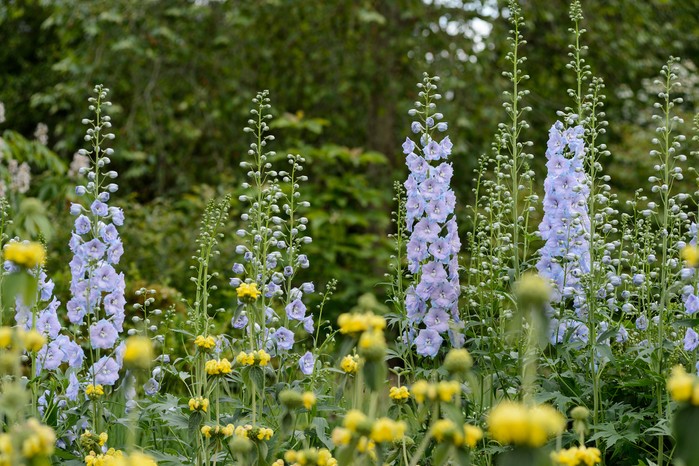
What is larkspur?
Larkspur is a cottage garden plant, adding height and colour to border displays. Flowers work well with roses, peonies and other tall-growing flowers such as lupins and verbascums. These flowers are usually blue but they also come in mauve, pink, white and even red. They can be single or double, depending on the variety. Single-flowered varieties are loved by bees.
What is the difference between larkspur and delphinium?
Larkspur is the common name for delphinium. The word delphinium comes from the Greek delphinos, meaning dolphin, thought to be due to the shape of the flowers as they open. The name larkspur dates back to Tudor times.
How to grow and care for larkspur
Grow larkspur in moist but well-drained soil in full sun. Larkspur struggles in wet winter soil, so on heavy soils aid drainage by adding grit to the planting hole. Protect emerging shoots from slugs in spring and stake as soon as they start to grow. Feed weekly with a high potash fertiliser. After flowering, cut stems back to encourage a second flush of blooms. Mulch in autumn with well-rotted manure or leaf mould.
Where to grow larkspur
Larkspur growing with yellow phlomis. Hilliers
Grow larkspur in moist but well-drained soil in full sun. They are tall plants, so work best at the back of a sunny border. Avoid windy spots, as wind can blow them over.
How to plant larkspur

Planting larkspur
You can plant larkspur at any of time of year, but ideally in spring or autumn as the soil will be warm and moist. Larkspur struggle in winter wet, so add grit to the planting hole to aid drainage if you need to. Plant at the same depth it was growing in the pot, and back-fill with soil, firming in gently. Water in well.
How to care for larkspur

Tying in larkspur stem to a support
Larkspur thrive in slightly moist soil in summer, so make sure plants don’t dry out in hot weather.
Apply a liquid fertiliser every two weeks to encourage strong growth.
Stake taller varieties, either with canes or a frame that plants can grow through.
Cut back flower spikes after they have faded to encourage more to form. Then cut the whole plant back to the ground in autumn.
Divide larkspur plants every few years, in spring.
How to propagate larkspur

Sowing larkspur seed
You can grow larkspur from seed from February to June, or September to October. Sow in small pots or seed trays and keep at a temperature of around 10-15°C.
You can also take larkspur cuttings from the base of the plant (known as basal cuttings) in spring.
To take basal cuttings from a larkspur:
- Take a sharp knife and cut a new shoot, just below the surface of the soil
- Place the cutting immediately into a polythene bag, to keep moisture in
- Cut off some foliage from the top of the cutting, leaving a few leaves to feed the roots
- Pot up each cutting into a small pot filled with peat-free, multi-purpose compost and perlite
- Water and cover with a polythene bag to keep moisture in, or mist regularly, to stop the leaves drying out
- Keep in the greenhouse or on a sunny windowsill
Growing larkspur: problem solving
In spring, as soon as the new shoots appear, protect them from slugs and snails – they will demolish the fresh green new growth of young larkspur. Use a garlic drench, organic slug pellets, or a biological control (which is only effective against slugs).
Larkspur can be susceptible to powdery mildew in dry weather, so keep the soil around them moist.
They can also be affected by rust, which causes rust-coloured pustules on the foliage. Pick off any affected leaves as you see them and clear up any fallen leaves in autumn.
Delphinium black blotch is a bacterial infection that causes large black blotches on larkspur leaves. It’s particularly common in wet summers and can affect the health of the whole plant. The only treatment is to remove affected plants to prevent the spread of this disease.
More like this
Advice on buying larkspur
- Bear in mind that larspur can become large, tall plants so check the ultimate size of the variety you are interested in before buying
- Larkspur grow best in a sunny spot so check that you have the right conditions in your garden
- You can buy larkspur at nurseries and garden centres, or from specialist retailers online
Where to buy larkspur online
Larkspur varieties to grow

Delphinium ‘Cassius’
1
Larkspur ‘Amadeus’
Deep-purple/blue flowers with a dark brown ‘eye’. It makes a spectacular cut flower.
Height x Spread: 1.5m x 1m
2
Larkspur ‘Pacific Hybrids’
Tall, stately larkspur plants in a range of colours. Quite short-lived, compared to other varieties.
H x S: 150cm x 75cm
3
Larkspur ‘Rising Stars’
This mixed variety has single or double flowers in a range of colours. Grown together they make a dramatic display, and they also make fantastic cut flowers.
H x S: 150cm x 75cm
4
Larkspur ‘Magic Fountain Series’
Compact plants in a range of colours, suitable for smaller gardens.
H x S: 90cm x 60cm
5
Larkspur ‘Faust’
Incredibly tall spikes of intense blue double flowers, with a dark centre.
H x S: 2.5m x 1m
6
Larkspur ‘Cinderella’
Compact, pale pink larkspur with very sturdy stems and triple blooms.
H x S: 1.2m x 80cm
